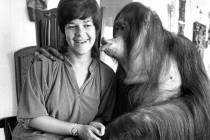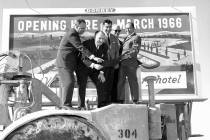Author separates ‘good hoods’ from ‘bad gangsters’

After 48 years researching the mob, author and gaming consultant Bill Friedman knows the difference between “good hoods” and “bad gangsters,” and his new book “30 Illegal Years To The Strip” examines the differences between the two.
One example of a “good hood” was the late Moe Dalitz, who came from the illegal liquor world spawned by Prohibition in the 1920s and transitioned into legal gambling in Las Vegas.
In 1968, Dalitz had trouble talking about himself with Friedman, who at the time was a young historical researcher on organized crime. Dalitz shied away from Friedman who for a year had stalked the man who came from the Cleveland mob and became a sterling citizen in Las Vegas.
Dalitz sat with him for two interviews, but then decided he couldn’t talk about himself, so he told Friedman to talk to others — and gave those others permission to talk about him.
Mark Swain, Dalitz’s chief enforcer, talked extensively to Friedman. Many years later, he told Friedman, “You think you and I became friends because I liked you. I didn’t. We told you things to find out who you were talking to and what you learned.”
Friedman said Swain was a top executive at the Stardust and also “a flat-out killer.” Dalitz was not a violent man but Swain “stopped problems.”
The author said Dalitz told associates, “This is the most aggressive personality I have ever met, except for (Sam) Giancana.” That was not a compliment, according to Friedman. “Giancana pushed people around.”
“At one point he (Dalitz) told me to stop my research and get out of town,” Friedman said. “Moe told me: You keep up this research, you’re going to put me in prison.”
The researcher never uncovered what would put Dalitz in prison, but was told the answer years later. Dalitz organized the skim of untaxed gambling winnings and hidden ownership at the Stardust from the 1960s through the 1980s, a major part of a future book.
At 73, Friedman plans to write more books that move the Las Vegas mob story from the 1950s until the beginning of the megaresort era starting in 1989.
It’s an ambitious goal and he admitted Tuesday he’s a slow and lengthy writer (I can relate) but he’s done nearly 600 interviews at least two hours long and often more. The interviews began in 1967 and ended in 1976 when he was working full time as a casino executive.
Friedman has the background many mob writers lacked. He grew up in Nevada, attended the University of Nevada, Reno, was a dealer for three years and eventually became president of the Castaways Hotel and the Silver Slipper.
Friedman approached his research from an historian’s angle. “I never asked a question that wasn’t at least 10 years old,” he said Tuesday from his home in Pahrump. “If you ask a recent question, they give you the most socially acceptable answer they can think of. After the 10-year mark, the body language changes and they actually get introspective.”
In the world of gamblers, liquor peddlers and organized crime, women were minor players with few exceptions. “There was no point in interviewing the wives because they didn’t tell their wives anything.”
So the 582 interviews were all guys.
Guys like Benny Binion, Bill Harrah, Jackie Gaughan and Major Riddle — all gamblers — and gaming regulators like Robbins Cahill and Ed Olsen and attorneys like Lou Wiener and Cliff Jones, who negotiated the early contracts for almost every Strip casino, according to Friedman.
Riddle described dating Virginia Hill, when she was a sweet girl in the 1930s before she linked with Ben Siegel. Later she became a foul-mouthed fun-time girl. Riddle told Friedman he wouldn’t have dated her then.
His 500-page opus details how illegal liquor and illegal gambling mixed with political corruption in places including Chicago and New York and ultimately chased the illegal casinos out of those places and into Las Vegas and Havana.
He describes the lives of the seven men who started with distributing illegal liquor during Prohibition and eventually made it to the top of the organized crime pyramid and transitioned into Las Vegas gambling — Dalitz, Siegel, Meyer Lansky, Charlie Luciano, Joe Adonis, Frank Costello and Vincent Alo.
Friedman said his goal was not to correct the record about organized crime, although he did that throughout, condemning false or speculative information. His goal was to show who these men actually are. “They were the most fascinating men and I wanted to understand them, who and what they really were, the good, the bad and the ugly.”
“All organized crime wants is to separate you from money, but gamblers want to separate you from money without pushing you around, without hurting you physically,” Friedman said.
That’s what distinguished the good hoods from the bad gangsters.
Jane Ann Morrison’s column appears Thursdays. Email her at jmorrison@reviewjournal.com or leave a message at 702-383-0275. Find her on Twitter: @janeannmorrison












